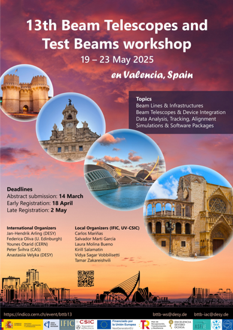Speaker
Description
Beam Tests for the Belle II VTX upgrade at High Temperatures with a Peltier-based heating and cooling device
The Belle II experiment currently records data at the SuperKEKB e+e– collider, which holds the world luminosity record of $5.1\times10^{34}cm^{-2}s^{-1}$ and plans to push up to $6\times10^{35}cm^{-2}s^{-1}$. In such a luminosity range for e$^+$e$^-$– collisions, the inner detection layers should both cope with a hit rate dominated by beam-induced parasitic particles and provide minute tracking precision.
An extensive R&D program foresees a pixelated vertex detector employing depleted MAPS detectors (VTX) as a replacement for the existing vertex detector (VXD).
The OBELIX sensor is derived from TJ-Monopix2, originally developed for the ATLAS experiment, which is studied in lab experiments and beam tests to establish its performance and provide valuable inputs for the design of OBELIX.
This contribution presents a beam test setup, consisting of an EUDET-type beam telescope, a TelePix time reference plane and TJ-Monopix2 as devices under test (DUT) previously irradiated to fluences between $10^{14}n_\mathrm{eq}\,cm^{-2}$ and $5\times10^{14}n_\mathrm{eq}\,cm^{-2}$.
The event synchronization of the DUT to the telescope setup has been updated from a trigger number based (EUDET-mode) to a time stamp based system (AIDA-mode).
These DUTs are tested at temperatures between 5 °C and 50 °C to investigate cooling requirements for larger detector systems. A dedicated temperature control system utilizing a Peltier element has been installed to achieve stable temperatures during measurements across a large temperature range. The presentation provides insights into the heating and cooling device and its performance during the beam test campaign.
